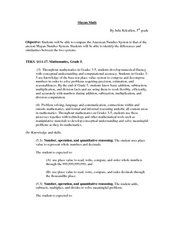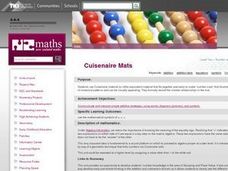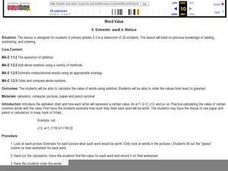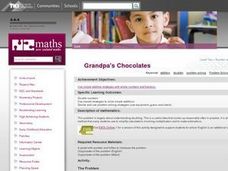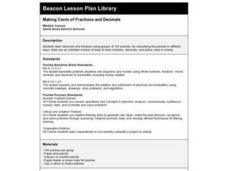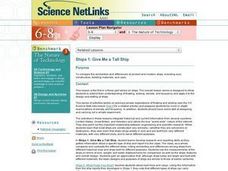Curated OER
Mayan Math
Fifth graders investigate the Maya's as mathematicians. In this Mayan math lessons, 5th graders work with the ancient Mayan numbering system by comparing it to the American Number System. They tell the differences and similarities...
Curated OER
Leaves for Our Tree
Young mathematicians review fact families and create a Math Fact Family Tree. This clever lesson plan includes some excellent printouts that support the instructional activity.
Curated OER
Minnesota-China Connections:What Time Is It?
Students calculate the time difference between Beijing, China and their local community. They discuss how time difference affects intercultural communication.
Curated OER
Cuisenaire Mats
First graders use Cuisenaire rods to study the mathematical symbols =, <, > for the relationships is equal to, is less than, and is greater than. They use the rods to show visual explanations of common number combinations.
Curated OER
Let's Dig Deeper!
Students investigate rocks and how they are formed and the uses man has for rocks. The topic is narrowed, researched, and documented by three sources. The results are presented to classmates for evaluation.
Curated OER
Word Value
Young scholars investigate the concepts of adding, estimating, and ordering. The lesson plan uses the alphabet as an example illustration. The students practice the calculations in class in order to ensure mastery.
Curated OER
Problem Solving with Multi-Step Number Stories
Pupils solve multi-step number stories. They create number models to solve number stories. Everyone chooses the appropriate operation to use after reading the problem, and then work in small groups to...
Curated OER
Grandpa's Chocolates
It's fun playing a game of "Guess What's in the Jacket Pocket?" Students read the question using the concept of doubles using mental math. They then share their solutions with the class.
Curated OER
"How Many Names for 100?"
Fifth graders work on the different possibilities of reaching the number 100. The class is divided into homogeneous groups for cooperative learning. The activity uses discussion questions to help with problem solving.
Curated OER
Area, Arithmetic and Algebra
Explore the concept of this perfect square trinomial and difference of squares lesson. A hands-on activity that uses paper rectangles and squares to illustrate the perfect-square trinomial and difference of squares formulas.
Curated OER
Making Cents of Fractions and Decimals
Students explore decimals and fractions using groups of 100 pennies. By classifying the pennies in different ways, there are an unlimited number of ways to learn fractions, decimals, and place value in money. This is a good, hands-on...
Curated OER
WebQuest: Thrills and Spills- Pick Your Park!
Learners participate in a WebQuest in which they must determine which amusement park is the "median priced" park. Students visit park websites to accumulate prices for parking, activities, restaurants, and gift shops.
Curated OER
World Cities of 5 Million or More
Students consult online resources to identify and map the world's largest cities and metropolitan areas. They analyze birth rates, settlement patterns and other demographic data and make predictions for the future. They write essays...
Curated OER
Word Roots 7: SPECT, STA, VERT Intermediate Synonym or Antonym Word Puzzle
Use word roots to help your class develop vocabulary acquisition skills. This particular resource focuses on the word roots SPECT, STA, and VERT. Leaners choose an antonym and a synonym from a word bank for each of 6 given words, keeping...
Curated OER
Give Me a Tall Ship
Sixth graders develop an understanding of floating, sinking, density, and buoyancy and apply it to the design of testing of ships.
Curated OER
Kaffee - und Teegesellschaften: German Foods
Introduce your Language students to the culture and 19th century German custom of serving coffee and cake at small parties. They read old cookbooks, sort recipes, prepare foods, compare old German recipes to recipes from home and convert...
Curated OER
Recycled Greeting Cards
Students create greeting cards from recycled products. They research how paper is recyled and the history of paper. They write free verse and create their own recycled paper. They use Microsoft Word to write their final drafts of verse...
Curated OER
Creating a Multiple Image Page
Students review basic computer skills and view images produced with multiplet images. They complete the Photo Draw Activities worksheet then create a multiple image composite page using computer graphic image programs and images found on...
Curated OER
Definition Expedition
Students study about three ways to define a term in technical writing, search the Web for scientific text, then copy and paste sections into a Word document. Finally, they use the highlighter feature of Word to highlight examples of...
Curated OER
Problem Solving Strategy for Multi-step Math Problems
Third graders analyze mathematical word problems and interpret the words into mathematical equations. Individuals demonstrate their knowledge of the order of operations both verbally and through written expression.
Curated OER
U.S. Imperialism PowerPoint Project
Eighth graders explore U.S. Imperialism. They explain why stronger countries take control of weaker countries. Students research Imperialism in other parts of the world. In groups, 8th graders create a PowerPoint presentation discussing...
Curated OER
The Yum -Yum Tree Dilemma
In this problem solving worksheet, students read a fictional passage about a tribe of people who need to gather wood from a particular tree. There are natural barriers to this task as well as vicious enemies to avoid. Students problem...
Curated OER
Sentence Order: "Tell Me Why!"
In this sentence order worksheet, students rearrange words to correctly put sentences together. Then they complete sentences in their own words. There are sixteen questions to complete.
Curated OER
Maps and Modes, Finding a Mean Home on the Range
Fifth graders investigate data from maps to solve problems. In this data lesson, 5th graders study maps and collect data from each map. Students present their data in a variety of ways and calculate the mode, mean, median, and range.


